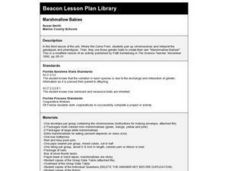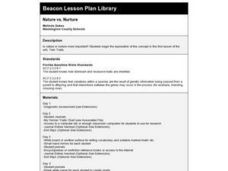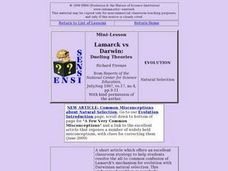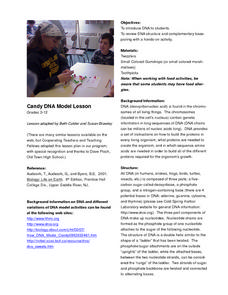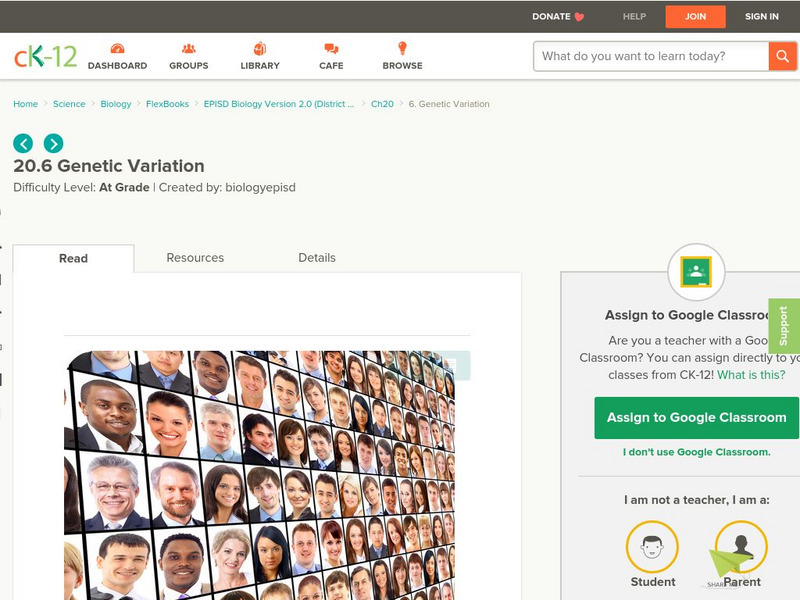Curated OER
Evolution: Adaptation
Tenth graders practice new skills and apply them. The skills of research should motivate them to want more knowledge. The concept of adaptation is used as a context for the lesson of practicing research skills.
Curated OER
Mussel Movements
Students consider the impact of invasive species on local environments. In this ecology lesson plan, watch the video, Arizona Wildlife Views, which focuses on invasive species. Students develop vocabulary, relate to meaningful...
Curated OER
Insect Biology and Ecology: A Primer
Students explore insects and closely related organisms. They examine the growth and development of a lady beetle. Students classify insects and organize them. They investigate pest management.
Curated OER
Mitosis vs. Meiosis
In this cell division worksheet, students compare and contrast the processes of mitosis and meiosis. Students complete 9 questions in a chart.
Curated OER
Gene Action and Mutation
Students review terms related to DNA structure and function. They complete a variety of worksheets in small groups or in pairs reflecting the unit's concepts regarding DNA. They submit their worksheets for grading.
Curated OER
How Things Go Wrong
Students identify where mutations might occur and examine what effect those mutations will have through class discussion of DNA replication and cell division. Students then differentiate between mutations that affect individuals and...
Curated OER
Marshmallow Babies
Eighth graders interpret the genotypes and phenotypes, then pair up chromosomes.
Curated OER
How Does Evolution Work?
Students pretend they are a scientist like John Endler in this Web activity. They visit his pools, from hypotheses, and test them out. In the process, the explore about natural selection and sexual selection. They are able to explain the...
Curated OER
Sequencing the Cystic Fibrosis Gene: A Simulation
Ninth graders determine nucleotide sequences. They identify those base sequences that are normal, those that are normal variants and those that cause cystic fibrosis. Students use DNA nucleotide sequences to determine amino acid...
Curated OER
Karyotype Puzzle
Young scholars identify chromosome pairs based upon band patterns and location of centromere. They order chromosome pairs based upon size. Students differentiate normal karyotypes from abnormal karyotypes. They correctly record karyotype...
Curated OER
Nature vs. Nurture
Eighth graders investigate the concept of nature versus nurture in human development through this series of lessons.
Curated OER
Decoding DNA
Third graders complete their KWL charts from the first lesson of the unit as a review for the summative. Then they decode a secret message using the four basic components of DNA, adenine, cytosine, guanine and thymine.
Curated OER
Lamarck vs Darwin: Dueling Theories
Learners, in groups, study cheetah, blind cave organisms, and naked mole rats to explain facets of evolution.
Curated OER
Candy DNA Model Lesson
Young scholars explore DNA structure using materials such as Twizzlers, small colored gumdrops and/or toothpicks.
Curated OER
Panther Scavenger Hunt
Students examine the Florida Panthers through a Web-quest. In this web-based activity, students find clues that will help them to identify the habitat of the Florida Panther and the history of human activity which threatens these wild cats.
Curated OER
Pollen & Pollination
Students identify the different ways things are pollinated and how to manage pollen. In this pollination lesson students complete an experiment on how moths pollinate flowers.
Curated OER
Evolution, Genes, and Behavior
Students examine the roles of genes and evolution on behaviors. In groups, they identify the relationships among DNA, genes and chromosomes. They evaluate the different theories of language acquistion and how evolved tendencies interact...
Curated OER
Responding to Alcohol: What's Important?
Young scholars examine the effects on motor functions in mice. They make observations and graph their data. They analyze the data and draw conclusions in each of the three experiments.
Curated OER
Creative Ways To Teach Evolutionary Concepts
Learners explore evolutionary concepts in cartoons and lab activities. They describe and explain evolutionary concepts featured in a cartoon and participate in laboratory activities.
Curated OER
Living Corn Necklace
Fifth graders explore heredity and observable traits through experimentation. They view several different types of corn and record their observation of physical traits on a class chart. They create a corn necklace by sprouting dried...
Curated OER
Inheritance Word Search Puzzle
For this literacy worksheet, middle schoolers find the words that are related to the concept that is the theme of the word search puzzle.
CK-12 Foundation
Ck 12: Genetic Variation in Organisms
Genetic variation helps ensure the survival of a species. It is this variation that is the essence of evolution. Without genetic differences among individuals, "survival of the fittest" would not be likely. This activity discusses how...
CK-12 Foundation
Ck 12: Episd: Genetic Variation
[Free Registration/Login may be required to access all resource tools.] How does genetic variation protect species from extinction? Understand sexual reproduction and the importance of both random fertilization and independent assortment.
BiologyWise
Biology Wise: Genetic Diversity Explained With Examples
Explains what genetic diversity is, things that cause it, factors that affect it negatively, and why it is so important. Includes examples of the presence and absence of genetic diversity.
Other popular searches
- Human Genetic Variation
- Genetic Variation and Beans
- Genetic Variation Inquiry
- Bill Nye Genetic Diversity
- Genetic Variation Plants
- Process of Genetic Diversity
- Genetic Diversity Worksheet






